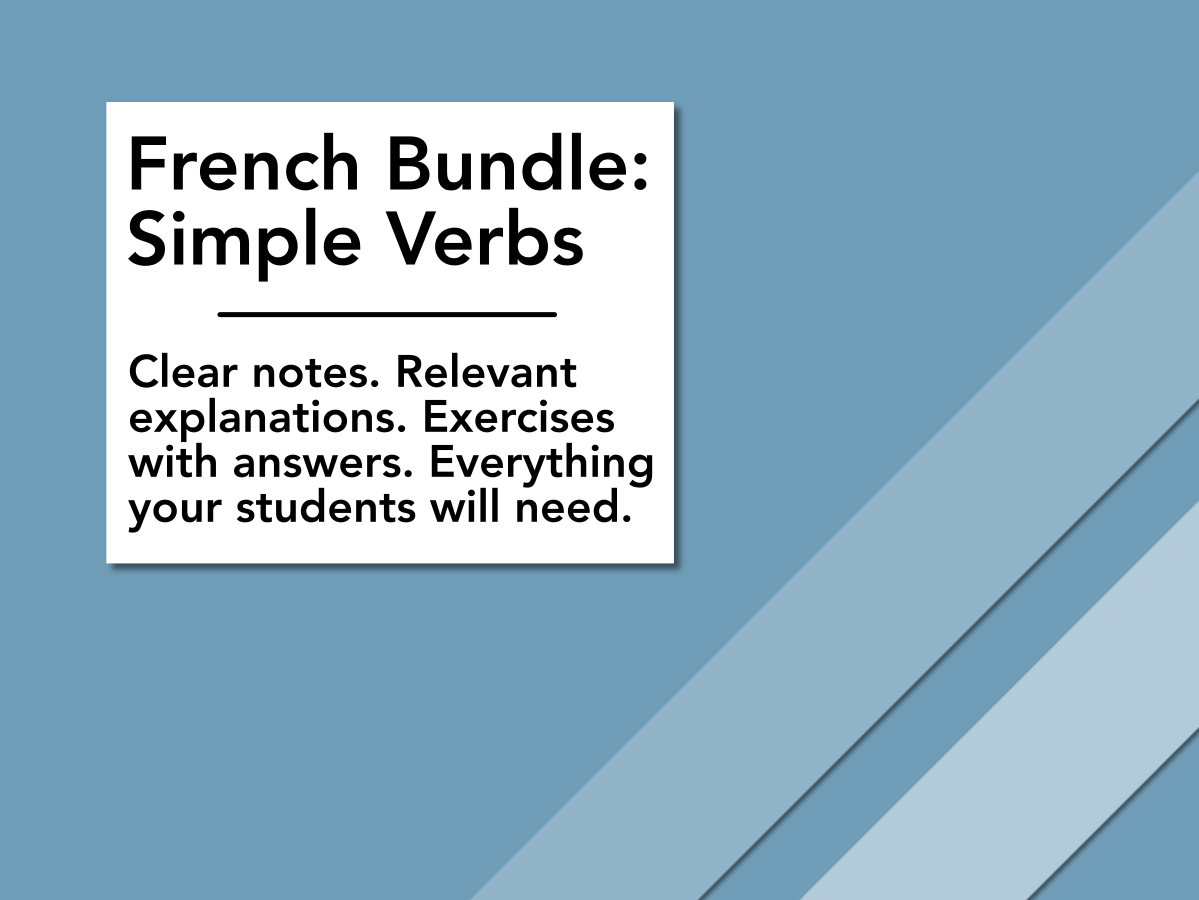13Uploads
982Views
159Downloads
Languages

Futur simple and conditionnel
This differentiated lesson explains the futur simple and conditionnel in several ways:
First, the structure is compared to English equivalents.
Second, the grammar is broken down in a very accessible way.
Third, a flow chart guides students through the teacher’s inner monologue to encourage confidence and independence.
Exercises of increasing complexity are followed by an answer key.
Appropriate for secondary French (KS3, KS4, GCSE) and beyond.

Passé simple
This differentiated lesson explains the passé simple in several ways:
First, the structure is compared to English equivalents.
Second, the grammar is broken down in a very accessible way.
Third, timelines with playful characters explain the appropriate uses of verb forms in relation to one another.
Exercises of increasing complexity are followed by an answer key.
Appropriate for secondary French (KS3, KS4, GCSE) and beyond.
Bundle

French: Simple Verbs
SAVE 62%
This bundle contains 10 resources that will make it easy for your students to learn single-word verb forms in French.
Based on real experience, the lessons are engaging and structured to address the needs of students with various learning styles.
In order to create a successful experience for your students, each resource contains some or all of the following:
Comparisons with English equivalents.
Explanations of the grammar.
Flow charts showing the teacher’s thought process when using the structure.
Timelines with cartoon characters.
Exercises with answers on a separate page.
Appropriate for secondary French (KS3, KS4, GCSE) and beyond.
All content is completely original.

Uses of the conditionnel
This supplemental note accompanies the resource entitled “Futur simple et conditionnel,” which contains the appropriate explanations of verb forms and general usage as well as exercises and an answer key.
In this file, the focus is on politeness and possibility. Students will read examples emphasizing the cultural value of this verb form.
Appropriate for secondary French (KS3, KS4, GCSE) and beyond.

Futur after Quand
This differentiated lesson explains the use of future tenses in French with temporal conjunctions in several ways:
First, the structure is compared to English equivalents.
Second, the grammar is broken down in a very accessible way.
Third, timelines with playful characters explain the appropriate uses of verb forms in relation to one another.
Exercises of increasing complexity are followed by an answer key.
Appropriate for secondary French (KS3, KS4, GCSE) and beyond.

Subjonctif et des propositions relatives
This supplemental lesson accompanies the resource entitled, “Subjonctif présent,” which contains the appropriate explanations of verb forms and general usage.
In this file, the focus is on fuzzy contexts that may or may not trigger the subjunctive mood in French.
The exercises challenge the student to determine the different meanings of a sentence based on whether the subjunctive or the indicative is used. An answer key is included.
Appropriate for secondary French (KS3, KS4, GCSE) and beyond.

Conjunctions taking subjonctif
This supplemental lesson accompanies the resource entitled, “Subjonctif présent,” which contains the appropriate explanations of verb forms and general usage.
In this file, the focus is on certain conjunctions that trigger the subjunctive mood in French.
There are exercises which challenge the student to combine separate sentences using the conjunctions. An answer key is included.
Appropriate for secondary French (KS3, KS4, GCSE) and beyond.

Present Pronominal (Reflexive) Verbs
This differentiated lesson explains the present pronominal (reflexive) verbs in several ways:
First, the structure is compared to English equivalents.
Second, the grammar is broken down in a very accessible way.
Third, a flow chart guides students through the teacher’s inner monologue to encourage confidence and independence.
Exercises of increasing complexity are followed by an answer key.
Appropriate for secondary French (KS3, KS4, GCSE) and beyond.

Subjonctif présent
This differentiated lesson explains the subjonctif présent (present subjunctive) in several ways:
First, the structure is compared to English equivalents.
Second, the grammar is broken down in a very accessible way.
Third, a flow chart guides students through the teacher’s inner monologue to encourage confidence and independence.
Exercises for this introductory level of usage are followed by an answer key.
Appropriate for secondary French (KS3, KS4, GCSE) and beyond.

Imparfait
This differentiated lesson explains the imparfait in several ways:
First, the structure is compared to English equivalents.
Second, the grammar is broken down in a very accessible way.
Third, a flow chart guides students through the teacher’s inner monologue to encourage confidence and independence.
Exercises of increasing complexity are followed by an answer key.
Appropriate for secondary French (KS3, KS4, GCSE) and beyond.

Expressions taking subjonctif
This supplemental lesson accompanies the resource entitled, “Subjonctif présent,” which contains the appropriate explanations of verb forms and general usage.
In this file, the focus is on certain expressions that trigger the subjunctive mood in French.
There are exercises which challenge the student to determine whether the subjunctive or indicative should be used. An answer key is included.
Appropriate for secondary French (KS3, KS4, GCSE) and beyond.











